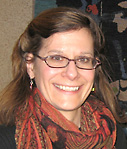A new living-learning community coming to North Campus this fall is unique among collegiate residential communities in this country. Living Arts, to be housed in Bursley Hall, unites students in the arts, engineering and other fields with programming focused on the development of students’ creative capacity.
“The goal of Living Arts is to spur and support creative work that knows no disciplinary boundaries,” says Theresa Reid, executive director of Arts on Earth, which developed and sponsors Living Arts. “We’re providing an open, playful, interdisciplinary residential community that enables students to pursue the kind of risky insights that might not occur in a traditional classroom environment.”
Living Arts residents benefit from curricular and co-curricular programming designed to spur creative interactions among students. The program brings students into close contact with resident and visiting faculty and artists from a wide variety of disciplines, mentoring by older students, and leadership opportunities.
“It’s important for students to have a safe place to experiment and ‘leap’ intellectually,” says Jean Leverich, who has been named Living Arts director. “Living Arts provides that space.”

Leverich. Photo courtesy University Housing.
Living Arts residents will take a specially designed course with guidance from faculty in engineering, visual and performing arts, architecture and other fields. Students will be encouraged to visualize and create innovative images and objects, original sound pieces, and imaginative solutions in space, motion, language and time. Residents also will benefit from a lecture-discussion series in which artists, engineers and others discuss their pursuit of interdisciplinary creative work.
Students will be able to take courses in English, math, physics and other subjects that are designed and taught in Bursley Hall specifically with the Living Arts mission in mind. Residents also will devise and drive interdisciplinary design and game challenges, competitions, exhibitions and performances of creative works, and study groups.
“Creative leaps thrive on two elements: deep knowledge and expertise in a subject area, and interaction with people whose knowledge and expertise differ from but complement each other’s,” Reid says. “Students’ work in their majors provides subject-area knowledge. Living Arts is designed to provide the catalytic interaction that can spark major creative insights and collaborations.”
Space in Bursley Hall will be repurposed for Living Arts programming, including a classroom and study lounge, as well as practice and studio spaces for creative work. These spaces will be available to all residents of Bursley.
“It’s well known that living-learning communities benefit not just the students enrolled, but most residents living in the host hall,” says E. Royster Harper, vice president for student affairs. “University Housing is thrilled to have this new residential learning community on North Campus. It will allow us to realize the enormous collaborative potential among our stellar arts, architecture and engineering units there, and across the university.”
“Living Arts will bring a new dynamic to living and learning at Michigan, and sets a standard for the entire country,” says David Munson, dean of the College of Engineering. “Catalyzing the creative, intuitive, analytical and intellectual, the program will provide a unique experience in trans-disciplinary collaborations among students and faculty.”

